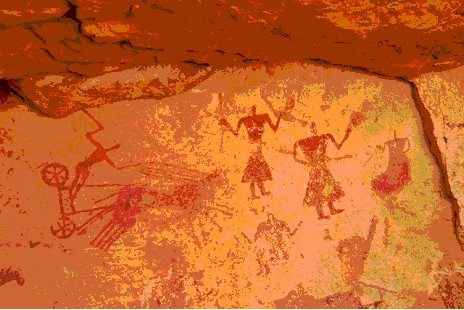కథ ఎంత పాతదో ఒక ప్రక్రియగా అంత కొత్తది.
పాతది ఎందుకూ అంటే కథ మూలాలు వెతకబోయిన వారందరూ మానవ సమాజ పరిణామ మూలాలలోకి వెళ్లటం దాదాపు అన్ని భాషలలోనూ జరిగింది. కొందరు ‘జరిగింది’ చెప్పటం కథ అంటారు. ‘జరిగిందానికి కారణాలు ఊహించి చెప్పటం’ కథ అనీ కొందరంటారు. ‘ఒక జరిగిన దానిని బట్టి మరేదో జరగబోతోందని చెప్పటం’ కథ అనీవారున్నారు. ఇవన్నీ ఇటీవలివారి ఆలోచనలు. వాటిని కాస్త పక్కనపెట్టి చూసినా పిల్లలు కథలంటే చెవికోసుకోటం మనకి అనుభవమే. అంటే కథలు చెప్పటం, చెప్పమనటం ఈనాడు కూడా మనచుట్టూ జరుగుతూనే ఉంది.
కథాతరంగాలు అనే కథాసంకలనానికి ముందుమాట రాస్తూ నేనిలా రాసాను,
“కథలు చెప్పటం, విషయాలను కథలుగా చెప్పుకోవటం మానవుడి లక్షణం.
ఇది చాలా పురాతనమైన విశిష్టమైన లక్షణం.
ఇది మానవ ప్రవృత్తిలో కీలకమైన అంశానికి బాహ్యరూపం.
ఆ కీలకాంశం ఏమిటీ- అంటే
నాకు వచ్చిన ఆపద మరొకరికి రాకూడదు.
నేను నేర్చిన మెలుకువ మరొకరికి ఉపయోగపడాలి.
నాకు కలిగిననొప్పి మరొకరికి కలగరాదు.
నేను పొందిన ఆనందం మరొకరు పొందాలి.
ఈ కీలకమే, దీని బాహ్యరూపమే సైన్స్ కీ, తత్వ శాస్త్రాలకి, సాహిత్యానికి పునాది.
మాట నేర్వకముందే తాను ఎదుర్కొన్న జంతువుల గురించి కొండగుహలలో బొమ్మలు వేసాడు మనిషి.
భాష ఏర్పడకముందే ఆడాడు, పాడాడు మనిషి”

మాట నేర్వకముందే బొమ్మలలో చూపిన కథ, రాత నేర్వకముందే కథగా చెప్పటం అయింది.
మానవజాతిలో తొలి కథకుడు తనకి తెలియకుండానే ఒక పని చేసాడు. గతాన్ని నమోదు చేయటం. అంటే అతను కాలానికి ప్రాతినిధ్యం వహించాడన్నమాట. ఈయన తను చెపుతున్నదానిని మనసులో పునర్నిర్మించుకోవాలి. దానిని గుర్తుంచుకొనేందుకు వీలుగా పద్దతులు తయారు చేసుకోవాలి. పక్కనే కూర్చుని వింటుంటాడు శ్రోత. కథ మొదలెట్టగానే అతనిలో కుతూహలం కలిగించాలి. చెపుతుంటే దానిలో నిమగ్నమైపోవాలి. తాను అందులో మునిగిపోకుండా శ్రోత మునిగిపోయేందుకు ఎప్పటికపుడు మెలకువలు అలవరచుకోవాలి. అరేబియన్ నైట్స్ కథలు గుర్తు చేసుకోండి. శుకసప్తతి గుర్తు చేసుకోండి. కథ చెప్పి ఉరిని వాయిదా వేయిస్తుందే వేయిన్నొక్కరాత్రుల కథకురాలు. కథ చెప్పి పరపురుషుని కోసం వెళ్లటాన్ని వాయిదా వేయిస్తుంది ఒక చిలక శుకసప్తతిలో. మా చిన్నపుడు కొండతాత అని మామామ్మ తమ్ముడుండేవాడు. ఆయన కథ చెప్పటం మొదలుపెట్టి మధ్యలో ఆపి అందరిచేతా పనులు చేయించుకునేవాడు. ఇలా ఈ కథ రంజుగా చెప్పటం అనేది చతుష్షష్టి కళలలో నేరుగా లేకపోయినా దీనినుంచే పుట్టిన కవిత్వం వేదాలు వంటివన్నీ కూడా అందులోకి చేరిపోయాయి.
ఈ కథలు ఒకచోటే పుట్టి ప్రపంచమంతా వ్యాపించాయా అనిపించేంత పోలికలు కనిపిస్తాయి.
ఉదాహరణకి పాతనిబంధనలోని మోజెస్ కి మహాభారతంలోని కథకి పోలిక. రామాయణంలోని భార్యపహరణం వంటివి గ్రీకు కథలలోనూ కనిపిస్తాయి. ఆప్రికన్ కథలలో కనిపిస్తాయి. గ్రీకు దేవుడు క్రూనోస్ లాగే మన కంసుడు శిశువులని చంపుతాడు. దేవుళ్లంటే చావులేని వాళ్లు. సరే పెద్ద గాలివాన, వరద మనం ప్రళయం అనే పేరుతో గుర్తించేది అన్నిచోట్లా ఏదో రూపంలో తారసపడుతూనే ఉంటుంది.
ఇవి ఒకచోట పుట్టి మరోచోటుకి వ్యాపించి ఉంటాయన్న ఆలోచన ప్రాశ్చాత్య మేధావులది. మానవ సమాజ పరిణామం ప్రపంచమంతా చిన్నిచిన్ని తేడాలతో ఒకేలా సాగిందన్నది చాలామంది అంగీకరిస్తున్న విషయం. కనక కథ చెప్పుకోటం లేదా గతాన్ని గుర్తుంచుకోటం అనేది ఒకదానితో ఒకటి భౌగోళికంగా సంబంధంలేని ప్రాంతాలలో దేనికదిగానే పుట్టిఉండాలని నేను అనుకుంటాను. నిప్పు వాడకం ఒకచోట ఆరంభమై వ్యాపించే అవకాశం కన్న అనేక చోట్ల విడివిడిగానే జరిగుండ వచ్చని నాకు అనిపిస్తుంది.
ఎందుకంటే-
అన్నిచోట్లా మనిషి ఎదుర్కొన్న పరిస్థితులు ఒకటే. తనకి ముప్పు కలిగించే ప్రకృతి మార్పులు, రాత్రుళ్లు, పగళ్లు, వానలు, వరదలు, ఎండలు, చలులు, దాడిచేసే జంతువులు, కాటువేసే పాములు .. ఇవి కలిగించే భయాలు, వాటిని ప్రసన్నం చేసుకోవాలనిపించటం, అవే తొలి దైవాలు అంటే తన జీవితాన్ని శాసించే శక్తులు. ఈ పరిస్థితులనుంచే తనకన్న శక్తివంతమైనవి తనకన్న ఎక్కువ తలలు, చేతులూ, కాళ్లూ కలిగింటాయనే ఊహ పుట్టటానికి అవకాశం ఉంది. ఒక ప్రాంతపు ఊహ కొంతకాలానికి సుదూరాలకి వ్యాపించటానికి ఎంత అవకాశం ఉందో వివిధ ప్రాంతాలలో ఒకేరకమైన ఊహలు కలగటానికీ అంతే అవకాశం ఉంది.

కథ మూలాల గురించి మాటాడుకునేటపుడు ఈమాత్రం చెప్పుకోవాలి. దీనిని మానవప్రవృత్తి అనే పదంతో గుర్తించితే మానవజాతి అంతటికీ వర్తించే సాధారణాంశం మనకి కొంత అందుతుంది. తన జీవితాన్ని శాసించేవాటిని గురించి ఆలోచనా, భయం, ప్రసన్నం చేసుకోవాలనే ఊహా, వాటిని అధీనం చేసుకోవాలనే ఆకాంక్ష వెరసి ప్రకృతితో మానవుని పోరాటం అనే తాత్విక భావనకి దారితీసింది. ఈ పోరాటంలో చేతుల వాడకం ఎంత ప్రధానమయిందో కారణాలు ఊహించి కథలు చెప్పుకునే లక్షణం కూడా అంతే ప్రధానమయింది.
ఈ చెప్పుకునే కథలు ఒకవిధమైన తూగు, లయ, కొన్ని పదేపదే వాడే పదాలతో ఒక విధమైన పాట లేదా పద్యం రూపంలో(verse) ఉండేదనే ఆలోచన దాదాపు అందరూ అంగీకరించే విషయం. వచనం కన్న పద్యమూ లేదా పాట జ్ఞాపకముంచుకోటానికి వీలైన రూపం.
ఈరూపంలో ఉన్న పురాగాధలను, ఊహలను, ప్రార్ధనలను కంఠోపాఠం గానే గ్రంధస్తం చేసారు. వేదాలలో ఉండే వీటినన్నింటినీ వ్యాసుడు ఒక క్రమంలో ఉంచినట్లు మన పూర్వగ్రంధాలు చెపుతాయి. అంటే గ్రంధస్తం అవటం అనే ప్రక్రియ లిపి పుట్టక ముందే జరిగింది. మనం వేదాలను శబ్దంతో సహా భద్రంగా ఉండేటట్లు ఉంచుకున్న విధానం చాలా విశిష్టమైనది.
లిపి దూరప్రాంతాలకు వర్తకం కోసం వెళ్లేవారి అవసరాల నుంచి పుట్టిందంటారు. అక్షరమాల(alphabet) వ్యాప్తిలోకి వచ్చాక కంఠోపాఠం రూపంలో గ్రంధస్తమైన గాధలను లిఖితరూపంలోకి తీసుకువచ్చారు.
అలా మనకి లభించిన అతి పురాతనమైన లిఖిత గాధ గిల్గమెష్ కథ. ఈ అవశేషం క్రీస్తుపూర్వం 6-7 శతాబ్దులనాటిదని శాస్త్రజ్ఞులు చెపుతారు. ఈ కథ గురించి రాంభట్ల కృష్ణమూర్తి వేల్పుల కథలో ప్రస్తావించారు.
ఇప్పటికీ జనం నోటిద్వారా బ్రతికి, వ్యాపించి కాగితాల మీదనూ కంప్యూటర్ల మీదనూ భద్రపరచబడిన కథలు అరేబియన్ వేయిన్నోక్క రాత్రుళ్లు, పంచతంత్రం, ఈసఫ్ కథలు, కాశీమజిలీలు, నిజమైన కాశీమజిలీలు, కథా సరిత్సాగరం, మదనకామరాజు కథలు, చార్ దర్వేష్ కథలు, మర్యాదరామన్న తెనాలిరామకృష్ణ, బీర్బల్ ఇలా ఎన్నెన్నో కథలు, కథామాలికలూ ఉన్నాయి.
లిపి వచ్చాక కథలు రాయటం వెంటనే జరిగిందా? లేదు.
చెప్పుకునే కథలను గ్రంధస్తం చేసుకోటానికే అవకాశం ఉంది. ఇలా రాతలోకి వచ్చిన గాధలు ఒకప్రాంతం నుంచి మరో ప్రాంతానికి వెళ్లటం చెప్పేవాళ్ల కల్పనాచాతుర్యంతో, సమకాలీన సందర్భాల అవసరాలకోసం నూతన కల్పనలతో మార్పులూ చేర్పులూ కూర్చుకున్నాయి. మన రామాయణ, భారతాలతో సహా ప్రపంచవ్యాప్తంగా అనేక ఇతిహాసాలు(Epics) ఈ పరిణామంలోనే రూపొందాయి. ఒకే మూలం నుంచి అనేక రూపాలూ వచ్చాయి. వివిధ మూలాలు కూర్చుకుని ఒకే రూపంగానూ ఏర్పడ్డాయి. ఇదంతా మానవుని ఉమ్మడి సృష్టి.
ఇలా లక్ష సంవత్సరాల క్రితం ఎప్పుడో ఆదిమ మానవుడు కథలు చెప్పుకోటం ఆరంభించాడు. తన వాస్తవానుభవాలకు కారణాలను ఊహించి చెప్పుకునే లక్షణం మానవ ప్రవృత్తిలో ఒక ముఖ్యాంశం అయింది. దాని నుంచే ఒక తరం మరో తరానికి తన స్మృతులనూ, శృతులనూ అందించుకుంది. చిత్రం, మాట రూపాలలో మనిషి కథలు చెప్పుకున్నాడు. రాత రూపంలో భద్రపరుచుకున్నాడు. తర్వాత వాటినే రాతలోనూ విస్తరించుకున్నాడు. ఈ క్రమమే మనం ఈరోజు గుర్తించుతున్న నాగరికతలకి పునాది అయింది.
ఇంత పురాతనమైన కథ ప్రక్రియగా కొత్తది ఎలా అయింది? చెప్పటం-వినటం నుంచి రాయటం-చదువుకోటంగా ఎప్పుడు మారింది? ఈ రెండూ ఒకటే అని ఎలా అనగలం? పోలికలేంటి? తేడాలేంటి?
తర్వాత మాటాడుకుందాం.
*









This ia going to be a valuable contribution sir… Thank you
చాలా నిశితమైన వివరణ. కానీ నాకు ఒక సందేహం. లిపి అనేది రాకముందే అంత భాషా జ్ఞానం ఎలాగ సాధ్యం? కష్టం కదా. నాకు అది అసాధ్యమేమో అనిపిస్తుంది.
భాషాజ్ఞానం అనటంలో మీ అభిప్రాయం నాకు అర్ధం కాలేదు. బహుశా విషయ పరిజ్ఞానం అన్నది మీ అభిప్రాయం కావచ్చు. ఇది కొన్ని వేల సంవత్సరాలపాటు మౌఖికంగానే జరిగిందని శాస్త్రజ్ఞుల పరిశీలన. వర్తమానంలో కూడా లక్షలాదిమంది రాయలేరు. కాని వారికి చాలా విషయ పరిజ్ఞానం ఉంది.
వ్యాసం చాలా బాగుంది. కథ మానవుని ఉమ్మడి సృష్టి అనేది అక్షరాలా నిజం.
కొన్ని ప్రత్యామ్నాయ సూచనలు:
1. లిపి కథకోసం పుట్టలేదు. అకౌంట్ ల కోసం పుట్టింది. సుమేరియన్ నాగరికతలో దొరికిన మొదటి రాతలు చూస్తే (3500BCE) చూస్తే, లెక్కలు చూసుకోవటానికి రాత పుట్టింది అని తెలుస్తుంది. మనకి దొరికిన మొదటి రాతల్లో కవిత్వం, కథలు ఏమీ లేవు. ఈ లెక్కలే రాసి రాసి, తిరగరాసి కనబడుతుంది. ఈ రాతగాళ్ళు రాజ్యంలో ముఖ్యులు అయ్యారు. [Ref: Sapiens: A Brief History of Humankind ]
2. The earliest stories written were not really stories, but propagation of ways of doing things. For instance, the current interpretation of the paintings in the caves is that they are not stories — but rituals of hunting. The surviving rituals from aborigines attest to similar interpretation.
3. The way this article expressed, stories are meant as altustic or knowledge transmission. There is some truth to that. However, the bigger, implicit purpose is that they stitched a society together. A society is held together by shared beliefs (rituals, historical stories, or alligience to the clan, or fight against the other clan etc). The story of Gilgamesh is something similar.
4. In anthropology, there is a much debated concept of cultural diffusion. Most people (at least currently) accept the theory of cultural diffusion, instead of sudden coincidences. The way I understood (which is a bit of copout) is that at least similar conditions happened through cultural diffusion to which similar responses happened in different cultures.
5. Use of fire (or other inventions) do not come under cultural diffusion concept. There are other theories about that. Also, at least there is some sort of evidence that fire usage predates even us, the homo sapiens. The control of which, happened to different degrees at different places. As such, fire is a naturally occuring phenomenon. So, it’s usage is widespread. Abstract concepts are lot more complex to evolve independently.
6. I also subscribed to the idea of many heads and many hands for Gods. When I started reading about Venus figurines (they date back to 35000 BCE — really really old). They do not have many hands or heads. They do have large breasts, large buttocks, and exaggerated genitalia. The figures are about sex and reproduction. The other old figurines survived show people with heads of lions or other animals. (example: Lowenmensch figurine) This kind of animal + person combo jives with lot of old cultures. Many headed, many limbed Gods seem later day invention.
I found a few more problamatic assertions — too tired to type now.
Perhaps the author is using some other references — and the discrepencies can easily be explained. The article would benefit from citing such references, at the risk of losing easy readability. Perhaps, the references can be moved to footnotes and maintain same lively style of narration.
రామారావు గారూ బహుకాల దర్శనం. బాగున్నారా.. నా వ్యాసం చదివినందుకు ముందుగా కృతజ్ఞతలు. సరిగా చదవనందుకు ఆశ్చర్యం కలిగింది. అలక కలిగింది,
౧.లిపి పుట్టుక గురించి నేనన్నదిది లిపి దూరప్రాంతాలకు వర్తకం కోసం వెళ్లేవారి అవసరాల నుంచి పుట్టిందంటారు. లెక్కలు అంకెలు ముందు పుట్టాయనే నేనూ చదివాను. కథల కోసం లిపి పుట్టటమేంటి సార్.. అర్ధం లేకుండా..
౨. అనేక అవయవాలుండటం, జంతువుల తలలో మోండాలకో మనుషుల మొండాలో తలలో ఉండటం మన మైధాలజీలో అందరికీ తెలిసినవే. వాటికి రిఫరెన్సులు ఎందుకు సర్..
త్రీ, గుహాచిత్రాలు కర్మకాండ తెలియబరుస్తాయన్నది ఒక ఊహ. అది నేనూ చదివాను. తమ అనుభవాలు ఘటనలూ అన్నది నా ఊహ. నా ఊహ మూకు సబబుగా లేదంటే సరే.
౪. The way this article expressed, stories are meant as altustic or knowledge transmission. There is some truth to that. However, the bigger, implicit purpose is that they stitched a society together. A society is held together by shared beliefs (rituals, historical stories, or alligience to the clan, or fight against the other clan etc). సమూహం(తెగ, గోత్రం, గణం వంటివి) ఒకటిగా ఉంచటంలో కథలు లేదా కథకుల పాత్ర నా రాబోయే వ్యాసంలో రాస్తున్నాను. మీరు కొంత అదనపు వెలుతురు పంచారు. చాలా సంతోషం.
౪. ఒక ప్రాంతం నుంచి మరోక ప్రాంతానికి జ్ఞానం వ్యాపించటం నా అవగాహన ప్రకారం తరవాత కాలాలకు వర్తిస్త్తుంది. మీరంటున్నదీ అదే అనుకుంటాను.
౫, The earliest stories written were not really stories, but propagation of ways of doing things. నా వ్యాసం మరోమారు శ్రమపడి చదివి అలా అనిపించిన వాక్యాలు చూపితే నేను నా వ్యక్తీకరణని సరిచేసుకోనే సహాయమవుతుంది.
౬. I found a few more problamatic assertions — too tired to type now. దయచేసి అవీ చెప్పండి. నాకు ఉపయోగపడతాయి. మరోమారు కృతజ్ఞతలతో
Yes, long time. Last we met on FB :-). I remember some comments about GDP, FDI numbers etc. That interaction prompts me to say the following: My comment in no way, should be construed as limiting your freedom of expression. I fully support in saying what you believe in, even if I disagree with it. [FWIW, I agree with the main points, despite some side issues.] I really want to see you write this series.
1. You are right about my mistake about incomplete (I kind of missed that statement) reading of the origin of script. Mea culpa. లిపి దూర ప్రాంతాల కోసం వెళ్లే వర్తకుల కోసం కూడా పుట్టలేదు. కేవలం లోకల్ వాళ్ళ కోసం పుట్టింది :-). Just like Geometry was born to keep track of the land holdings.
లెక్కలు అంకెలు ముందు పుట్టాయనే నేనూ చదివాను — I did not read it. I did not even say in my comment. [I am surprised that you did not read it carefully]. లెక్కలు చూసుకోవటానికి రాత పుట్టింది. I stated the purpose, not that numbers were the first symbols.
The first writing survived in the history is supposed to be: 29,086 measures barley 37 months Kushim. Along with numbers, names, places etc also were part of the first writings. Kushim is the name of the accountant.
2. You wrote: “ఈ పరిస్థితులనుంచే తనకన్న శక్తివంతమైనవి తనకన్న ఎక్కువ తలలు, చేతులూ, కాళ్లూ కలిగింటాయనే ఊహ పుట్టటానికి అవకాశం ఉంది. ” అనేక అవయవాలు నేను చూసినంత వరకు, హిందూ సంప్రదాయం (లేదా, దానికి దగ్గరి సంప్రదాయం) లోనే కనబడుతుంది. గ్రీక్ మిత్స్ లో కనబడదు (అరుదు గా తప్ప). వీటన్నిటికీ ఇంకా ప్రాచీనమైన సంప్రదాయాల్లో అసలు కనబడదు — Most importantly fertility figures were some of the first to apear. Unless you have some other source to put many headed/limbed Gods before these figurines, this seems somewhat a throwaway sentence. You are drawing inference like ఈ పోరాటంలో చేతుల వాడకం ఎంత ప్రధానమయిందో కారణాలు ఊహించి కథలు చెప్పుకునే లక్షణం కూడా అంతే ప్రధానమయింది, which is problematic. For instance, there is no Norse god with many hands. No Greek God with many hands.
the sentence: తన జీవితాన్ని శాసించేవాటిని గురించి ఆలోచనా, భయం, ప్రసన్నం చేసుకోవాలనే ఊహా, వాటిని అధీనం చేసుకోవాలనే ఆకాంక్ష వెరసి ప్రకృతితో మానవుని పోరాటం అనే తాత్విక భావనకి దారితీసింది. is really good and it needs better support than problematic scientific allusions. This thesis itself can be an essay in itself.
3. These sentences suggest the story purpose: నాకు వచ్చిన ఆపద మరొకరికి రాకూడదు.
నేను నేర్చిన మెలుకువ మరొకరికి ఉపయోగపడాలి.
నాకు కలిగిననొప్పి మరొకరికి కలగరాదు.
నేను పొందిన ఆనందం మరొకరు పొందాలి.
I don’t beleive that was the origin of the story telling. It seems to suggest an individualistic idea. It was collective idea, the idea of story telling.
Again here: గతాన్ని నమోదు చేయటం. అంటే అతను కాలానికి ప్రాతినిధ్యం వహించాడన్నమాట. — I do not believe historical perspective was important for most story telling in the initial days. It was the purposeful myth creation that was of the importance.
ఒక ప్రాంతపు ఊహ కొంతకాలానికి సుదూరాలకి వ్యాపించటానికి ఎంత అవకాశం ఉందో వివిధ ప్రాంతాలలో ఒకేరకమైన ఊహలు కలగటానికీ అంతే అవకాశం ఉంది. — Most anthropologists subscribe to the idea of cultural diffusion. You are assigning that theory equal footing. I thought you read some scientific studies backing that up. Also, you are conflating social structures like story telling with natually occuring phenomenon like fire usage. Most anthropologists separate these two types of ideas. [Again, may be you have some reason why you say that.]
ఇలా లక్ష సంవత్సరాల క్రితం ఎప్పుడో ఆదిమ మానవుడు కథలు చెప్పుకోటం ఆరంభించాడు.– This is a bit of stretch. If we are claiming 100,000 yr old story telling, we need to be careful. We do not have much of evidence. Not sure which part of the article deals with 100,000 years old. Yes, there are anthropologists that trace the story telling to very old times. It would have been great to talk about that.
Problematic statements: ఈ అవశేషం క్రీస్తుపూర్వం 6-7 శతాబ్దులనాటిదని శాస్త్రజ్ఞులు చెపుతారు. Gilgamesh story is considered to be written before 2000 BCE. Again, there may be scientists that say it is only 7century BCE. I would not know unless you give a reference. 7Century BCE is not common wisdom.
In general, the biggest issue for me is conflating different times. If you are looking at the strories from 35000 BCE, we have speculations backed up different archelogical theories. If we are looking at say, 7000 BCE, we have earliest writings. We have organized religion during Egyptian empires. If we are talking mythologies, we are in 1000 BCE. Perhaps you are not taking a chronological view. They are all mixed up in the narration.
The other big issue for me is that you are stating things that are not commonly accepted views. If that is your intent, I, as a reader, would like references. If that is because you did not do the research, I cannot believe it :-). Or, add caveats about it so that I, as a reader, would not take the claims seriously. May be that is what you mean by “ఊహ”.There are red herrings, with brilliant observations. There are obvious mistakes, with profound insights.
The third minor issue for me is the meandering nature of the essay. The thesis is not clear. The big picture is not clear. The path is not clear. I am used to topic sentences, inverted pyramid style of writing etc. the lack of such rhetoric style forces me to bring minor sentences to the forefront, which, I am sure is a mistake on my part. [I could give details, but perhaps that is not necessary].
Please do not think of it as an attack on you. I know and respect you as an acute observer of human mind. I read the essay three times so far. If I missed the point, perhaps, the minor issue I mentioned last may be the reason.
I do not have any more to contribute to the discussion. With deep wishes that you would continue to write this series, I look forward to reading them more.